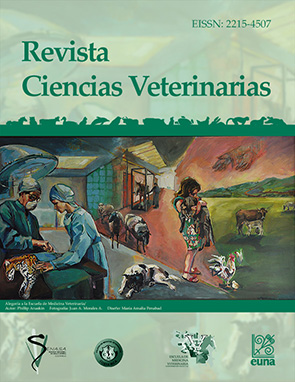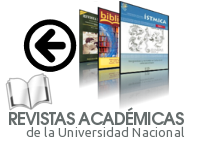A review of the aspects for nutrition and feeding assessment in dairy cattle herd health programs I: herd assessment
DOI:
https://doi.org/10.15359/rcv.35-1.1Keywords:
production, milk, livestock, information systems, healthAbstract
Feeding plays a key role in dairy cows’ performance and is mainly aimed at fulfilling their nutritional requirements, guaranteeing their digestive function and health, and optimizing use of available resources and feed rations, in order to obtain the most optimal feeding benefit-profit ratio. Therefore, feeding practices used should meet one or all of the previous objectives. The purpose of this review is to indicate the main aspects that should be considered at the very least regarding dairy cattle feeding in veterinary herd health programs for dairy farms and as support to the veterinary’s work. In addition, different managing and medical aspects, especially regarding feeding, are integrated here to motivate veterinarians attending dairy farms to develop and use the best tools and methods for farms. Aspects that can be measured and evaluated in practice are also described and used as a reference to control feeding, the animals’ nutritional status, ruminal health, performance and ration balancing. Nutrition and feeding aspects mentioned here include feed intake, body condition, energy balance, milk production, nitrogen metabolism and digestive function and health. Finally, it is concluded that feed managing in farms must be supported by an overall analysis of the data obtained through the feeding system assessment, together with other aspects such as production and reproduction; in addition, the entire work crew must be involved in the evaluation of results. Efforts must be directed towards reaching the goals initially proposed for the feeding system.References
Aguilar, M., Hanigan, M., Tucker, H., Jones, B., Garbade, S., McGilliard, M., Stallings, C., Knowlton, K. & James, R. 2012. Cow and herd variation in milk urea nitrogen concentrations in lactating dairy cattle. Journal of Dairy Science. 95(12): 7261–7268. doi:10,3168/jds,2012-5582.
Allen, M. & Bradford, J. 2008. Nutritional control of feed intake in dairy cattle. In Florida Nutrition Conference. p. 138–148.
Aquino, A., Lima, Y., Botaro, B., Alberto, C., Peixoto, K. & Santos, M. 2008. Effects of dietary urea levels on milk protein fractions of Holstein cows. Animal Feed Science and Technology. 140(1/2): 191–198. doi:10,1016/j.anifeedsci,2007,03,005.
Berry, D., Buckley, F. & Dillon, P. 2011. Relationship between live weight and body condition score in Irish Holstein-Friesian dairy cows. Irish Journal of Agricultural and Food Research. 50(1): 141–147.
Bohuslav, Č., Martínková, L., Podkowka, Z., Lad, F., Šoch, M. & Ingvortová, M. 2013. The Influence of Protein Feed Supplements for Composition of Cow Milk. Scientific Papers: Animal Science and Biotechnologies. 46(1): 23–26.
Blokhuis, H., Veissier, I., Miele, M. & Jones, B. 2010. The Welfare Quality Project and beyond: Safeguarding farm animal well-being. Acta Agric Scandinavica section A-Animal Science. 60(3): 129-140.
Brand, A., Noordhuizen, J. & Schukken, Y. 1996. Herd Health and Production Management in Dairy Practice. Wageningen Press. Wageningen, Holanda. 543 pp.
Burgos, S., Embertson, N., Zhao, Y., Mitloehner, F., DePeters, E. & Fadel, J. 2010. Prediction of ammonia emission from dairy cattle manure based on milk urea nitrogen: relation of milk urea nitrogen to ammonia emissions. Journal of Dairy Science. 93(6): 2377–86. doi:10,3168/jds,2009-2415.
Busato, A., Faissle, D., Küpfer, U. & Blum, J. 2002. Body condition scores in dairy cows: associations with metabolic and endocrine changes in healthy dairy cows. Journal of Veterinary Medicine Association. 49: 455–460.
Butler, W. 2000. Nutritional interactions with reproductive performance in dairy cattle. Animal Reproduction Science. 60-61(1): 449–457. doi:10,1016/S0378-4320(00)00076-2.
Carvalho, P., Souza, A., Amundson, M., Hackbart, K., Fuenzalida, M., Herlihy, M., Ayres, H., Dresch, A., Vieira, L., Guenther, J., Grummer, R., Fricke, P., Shaver, R. & Wiltbank, M. 2014. Relationships between fertility and postpartum changes in body condition and body weight in lactating dairy cows. Journal of Dairy Science. 97(6): 3666–3683. doi:10,3168/jds,2013-7809.
Cejna, V. & Chladek, G. 2005. The importance of monitoring in milk fat to milk protein ratio in holstein cows during lactation. Journal of Central European Agriculture. 6(4): 539-546.
Herdt, T. 2009. Fisiología y metabolismo gastrointestinal. In: Klein, B. (Ed.). Cunningham: Fisiología Veterinaria. 4a Edición. Elsevier. Madrid, España. p. 280-302.
Dado, R. & Allen, M. 1995. Intake limitations, feeding behavior, and rumen function of cows challenged with rumen fill from dietary fiber of inhert bulk. Journal of Dairy Science. 78(1): 118–113. doi:10,3168/jds.S0022-0302(95)76622-X.
Demeter, R., Markiewicz, K., van Arendonk, J. & Bovenhuis, H. 2010. Relationships between milk protein composition, milk protein variants, and cow fertility traits in Dutch Holstein-Friesian cattle. Journal of Dairy Science. 93(11): 5495–5502. doi:10,3168/jds,2010-3525.
DiGiacinto, A., Rojas, M., Estrada, S. & Romero, J. 2014. Bienestar animal en hatos lecheros especializados de Costa Rica asociados a una cooperativa de productores de leche. Revista Ciencias
Veterinarias. 32(1): 7-19.
Edmonson, J., Lean, I., Weaver L., Farver, T. & Webster, G. 1989. A body condition scoring chart for Holstein dairy cows. Journal of Dairy Science. 72(1): 68-78. doi: 10,3168/jds.S0022-0302(89)79081-0.
Escobosa, A. & Ávila, S. 2009. Alimentación. In: Avila, S. (Ed.). Producción de leche con ganado bovino. 2a Edición. Manual Moderno. México D.F, México. p 62.
Fatehi, F. & Young, J. 2012. Review of the relationship between milk urea nitrogen and days in milk , parity , and monthly temperature mean in Iranian Holstein cows. Journal of Dairy Science. 95(9): 5156–5163. doi: 10,3168/jds,2011-4349.
Ferraretto, L., Gencoglu, H., Hackbart, K., Nascimento, A., Dalla-Costa, F., Bender, R., Guenther, J., Shaver, R. & Wiltbank, M. 2014. Effect of feed restriction on reproductive and metabolic hormones in dairy cows. Journal of Dairy Science. 97(2): 754–763. doi:10,3168/jds,2013-6925.
Hall, M. 2015. Using manure Evaluation as a Diagnostic Tool for Feedng Programs. U.S Dairy Forage Research Center USDA-Agrucultural Research Service. Madison, Wi. http://www.ars.usda.gov/sp2UserFiles/Place/36553000/px-based_v3,2/educ-matrls/pdfs/PP_manure-evaluation_hall.pdf (accesado 23 noviembre 2015).
Hayton, A. 2012. Nutritional Management of Herd Health. En Green, M. (Ed.). Dairy Herd Health. CABI. Oxfordshire, Inglaterra. p. 227-278.
Holter, J. & Urba, W. 1992. Water Partitioning and intake in dry and lactating Holstein Cows. Journal of dairy science. 75(1): 1742–1749.
Ishler, V. 2008. Interpretation of milk urea nitrogen values. http://extension.psu.edu/animals/dairy/nutrient-management/certified-dairy/tools/interpret-mun-values-08134.pdf. (Accesado 22 enero 2016).
Kononoff, P., Heinrichs, J. & Varga, G. 2002. Using Manure Evaluation to enhance dairy cattle nutrition. http://www.vetmed.wsu.edu/courses-jmgay/documents/manure1.pdf. (Accesado 12 mayo 2015).
Malek dos Reis, C., Barreiro, J., Mestieri, L., Porcionato, M. & dos Santos, M. 2013. Effect of somatic cell count and mastitis pathogens on milk composition in Gyr cows. BMC Veterinary Research. 9(1): 67. doi:10,1186/1746-6148-9-67.
Maltz, E., Barbosa, L., Bueno, P., Scagion, L., Kaniyamattam, K., Greco, L., De Vries, A. & Santos, J. 2013. Effect of feeding according to energy balance on performance, nutrient excretion, and feeding behavior of early lactation dairy cows. Journal of Dairy Science. 96(8): 5249–5266. doi:10,3168/jds,2013-6549.
Miyazawa, K., Sultana, H., Hirata, T., Kanda, S. & Itabashi, H. 2007. Effect of brewer’s grain on rumen fermentation, milk production and milk composition in lactating dairy cows. Animal Science Journal. 78(5): 519–526. doi:10,1111/j,1740-0929,2007,00471.x.
Moran, J. & Doyle, R. 2015. Cow talk: Understanding Dairy Cow Behaviour to Improve Their Welfare on Asian Farms. CSIRO Publishing. Charles Sturt University. 256 pp.
Mucha, S. & Strandberg, E. 2011. Genetic analysis of milk urea nitrogen and relationships with yield and fertility across lactation. Journal of Dairy Science. 94(11): 5665–5672. doi:10,3168/jds,2010-3916.
Mulliniks, J., Cox, S., Kemp, M., Endecott, R., Waterman, R., Vanleeuwen, D. & Petersen, M. 2013. Relationship between body condition score at calving and reproductive performance in young postpartum cows grazing native range 1. Journal of animal science. 90(1): 2811–2817. doi:10,2527/jas2011-4189.
Murphy, M. & Davis, C. 1983. Factors affecting water consumption by Holstein cows in early lactation. Journal of Dairy Science. 66(1): 35–38.
National Research Council. 1974. Nutrients and Toxic Substances in Water for Livestock and Poultry. National Academy Press. Washington D.C.
National Research Council. 2001. Nutrient Requierements of Dairy Cattle,7a Edición. National Academy Press. Washington D.C.
Nayak, K., Kurrey, S. & Nanavati, N. 2012. Factors Affecting Milk Composition of Frieswal Cows. Indian Journal of Field Veterinarians. 7(3): 56–58.
Noordhuizen J. & Buurman., J.1984. Veterinary automated management and production control program for dairy farms (VAMPP). The application of MUMPS for data processing. Vet Q. 6(2): 66-72.
Nousiainen, J., Shingfield, K. & Huhtanen, P. 2004. Evaluation of milk urea nitrogen as a diagnostic of protein feeding. Journal of Dairy Science. 87: 386–398. doi:10,3168/jds.S0022-0302(04)73178-1.
Osborne, V.R. 2006. Water: The Forgotten Nutrient Background on Water “The Mega Molecule”. WCDS Advances in Dairy Technology. 18(1): 197–210.
Ponce, R. & Hernández, P. 2006. Relación entre desbalances nutricionales, el metabolismo y la composición de la leche en vacas holstein friesian. Revista Salud Animal. 28(1): 13–20.
Powell, J., Wattiaux, M. & Broderick, G. 2011. Short communication: Evaluation of milk urea nitrogen as a management tool to reduce ammonia emissions from dairy farms. Journal of Dairy Science. 94(9): 4690–4694. doi:10,3168/jds,2011-4476.
Randel, R. 2013. Nutrition and postpartum rebreeding in cattle. Journal of Animal Science. 68(1): 853–862.
Richards, M. & Proszkowiec-Weglraz, M. 2007. Mechanisms regulating Feed Intake, Energy Expenditure, and Body Weight in Poultry. Poultry Science. 86(1): 1487–1490.
Roche, J. 2006. The effect of nutritional management of the dairy cow on reproductive efficiency. Animal Reproduction Science. 96(1): 282–296. doi:10,1016/j.anireprosci,2006,08,007.
Roche, J., Friggens, N., Kay, J., Fisher, M., Stafford, K. & Berry, D. 2009. Invited review: Body condition score and its association with dairy cow productivity, health, and welfare. Journal of Dairy Sience. 92(12): 5769–5801. doi:10,3168/jds,2009-2431.
Romero, J., Rojas, J. & Estrada, S. 2011. El programa VAMPP Bovino, una herramienta para la toma de decisiones. Ventana Lechera. 16: 4-10.
Saborío, A. & Sánchez, J. 2013. Prevalencia y factores de riesgo relacionados con la cetosis clínica y subclínica tipo I y II en un hato de vacas Jersey en Costa Rica. Agronomía Costarricense. 37(2): 17–19.
Samková, E., Špička, J., Pešek, M., Pelikánová, T. & Hanuš, O. 2012. Review Animal factors affecting fatty acid composition of cow milk fat : A review. South African Journal of Animal Science. 42(2): 83–100.
Scandolo, D. 2007. Desbalance energía/proteína en la dieta. Revista del Colegio de Médicos Veterinarios de la provincia de Santa Fe. 25(181): 22–23.
Sheahan, J. & Kay, J. 2013. Carbohydrate supplements and their effects on pasture dry matter intake, feeding behavior, and blood factors associated with intake regulation. Journal of Dairy Science. 96(12): 7818–7829. doi: 10,3168/jds,2013-6981.
Spek, J., Bannink, A., Gort, G., Hendriks, W. & Dijkstra, J. 2013. Interaction between dietary content of protein and sodium chloride on milk urea concentration, urinary urea excretion, renal recycling of urea, and urea transfer to the gastrointestinal tract in dairy cows. Journal of Dairy Science. 96(9): 5734–5745. doi:10,3168/jds,2013-6842.
Spek, J., Gort, G., Hendriks, W. & Dijkstra, J. 2012. Effect of sodium chloride intake on urine volume, urinary urea excretion, and milk urea concentration in lactating dairy cattle. Journal of Dairy Science. 95(12): 7288–7298. doi: 10,3168/jds,2012-5688.
Stahel, P., Purdie, N. & Cant, J. 2014. Use of dietary feather meal to induce histidine deficiency or imbalance in dairy cows and effects on milk composition. Journal of Dairy Science. 97(1): 439–445. doi:10,3168/jds,2013-7269.
Stoop, W., Bovenhuis, H., Heck, J. & van Arendonk, J. 2009. Effect of lactation stage and energy status on milk fat composition of Holstein-Friesian cows. Journal of dairy science. 92(4): 1469–1478. doi:10,3168/jds,2008-1468.
Thorup, V., Edwards, D. & Friggens, N. 2012. On-farm estimation of energy balance in dairy cows using only frequent body weight measurements and body condition score. Journal of Dairy Science 95(4): 1784–1793. doi:10,3168/jds,2011-4631.
Van Knegsel, A., Remmelink, G., Jorjong, S., Fievez, V. & Kemp, B. 2014. Effect of dry period length and dietary energy source on energy balance, milk yield, and milk composition of dairy cows. Journal of Dairy Science. 97(3): 1499–1512. doi:10,3168/jds,2013-7391.
Van Lier, E. & Regueiro, M. 2008. Digestión en retículo-rumen. Universidad de la República. Montevideo, Uruguay.
Van Knegsel, A., Van den Brand, H., Dijkstra, J., Tamminga, S. & Kemp, B. 2005. Effect of dietary energy source on energy balance , production, metabolic disorders and reproduction in lactating dairy cattle. Reproduction Nutrition Development. 45(1): 665–688. doi:10,1051/rnd.
Van Soest, P. & Wine, H. 1967. Use of detergents in the analysis of fibrous feeds IV. Journal of Associated Officials of Agricultural Chemistry. 50(1): 50–55.
Van Straten, M., Shpigel, N. & Friger, M. 2009. Associations among patterns in daily body weight, body condition scoring, and reproductive performance in high-producing dairy cows. Journal of Dairy Science. 92: 4375–4385. doi:10,3168/jds,2008-1956.
Vibart, R., Washburn, S., Green, J., Benson, G., Williams, C., Pacheco, D. & Lopez-Villalobos, N. 2012. Effects of feeding strategy on milk production, reproduction, pasture utilization, and economics of autumn-calving dairy cows in eastern North Carolina. Journal of Dairy Science. 95(2): 997–1010. doi:10,3168/jds,2011-4755.
Wattiaux, M. & Howard, W. 2000. Alimentos para Vacas lecheras. Instituto Babcock para la investigación y desarrollo internacional de la Industria Lechera. Universidad de Wisconsin. Madison, Wisconsin.
Woodford, S., Murphy, M. & Davis, C. 1984. Water dynamics of dairy cattle as affected by initiation of lactation and feed intake. Journal of Dairy Science. 67(1): 2336–2346.
Zaaijer, D. & Noordhuizen, J. 2003. A novel scoring system for monitoring the relationship between nutritional efficiency and fertility in dairy cows. Irish Veterinary Journal. 56: 145–151.
Zebeli, Q., Dijkstra, J., Tafaj, M., Steingass, H., Ametaj, B. & Drochner, W. 2008. Modeling the adequacy of dietary fiber in dairy cows based on the responses of ruminal pH and milk fat production to composition of the diet. Journal of Dairy Science. 91(5): 2046–2066. doi:10,3168/jds,2007-0572.
Downloads
Published
How to Cite
Issue
Section
License
Licensing of articles
All articles will be published under a license:

Licencia Creative Commons Atribución-NoComercial-SinDerivadas 3.0 Costa Rica.
Access to this journal is free of charge, only the article and the journal must be cited in full.
Intellectual property rights belong to the author. Once the article has been accepted for publication, the author assigns the reproduction rights to the Journal.
Ciencias Veterinarias Journal authorizes the printing of articles and photocopies for personal use. Also, the use for educational purposes is encouraged. Especially: institutions may create links to specific articles found in the journal's server in order to make up course packages, seminars or as instructional material.
The author may place a copy of the final version on his or her server, although it is recommended that a link be maintained to the journal's server where the original article is located.
Intellectual property violations are the responsibility of the author. The company or institution that provides access to the contents, either because it acts only as a transmitter of information (for example, Internet access providers) or because it offers public server services, is not responsible.







